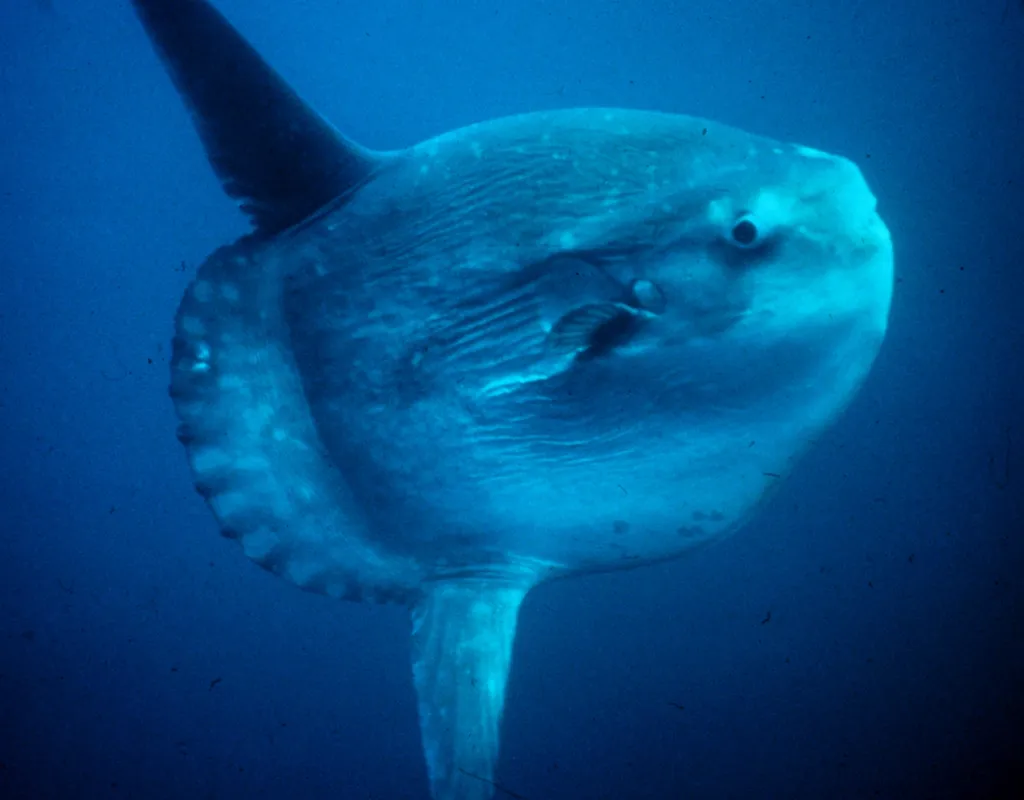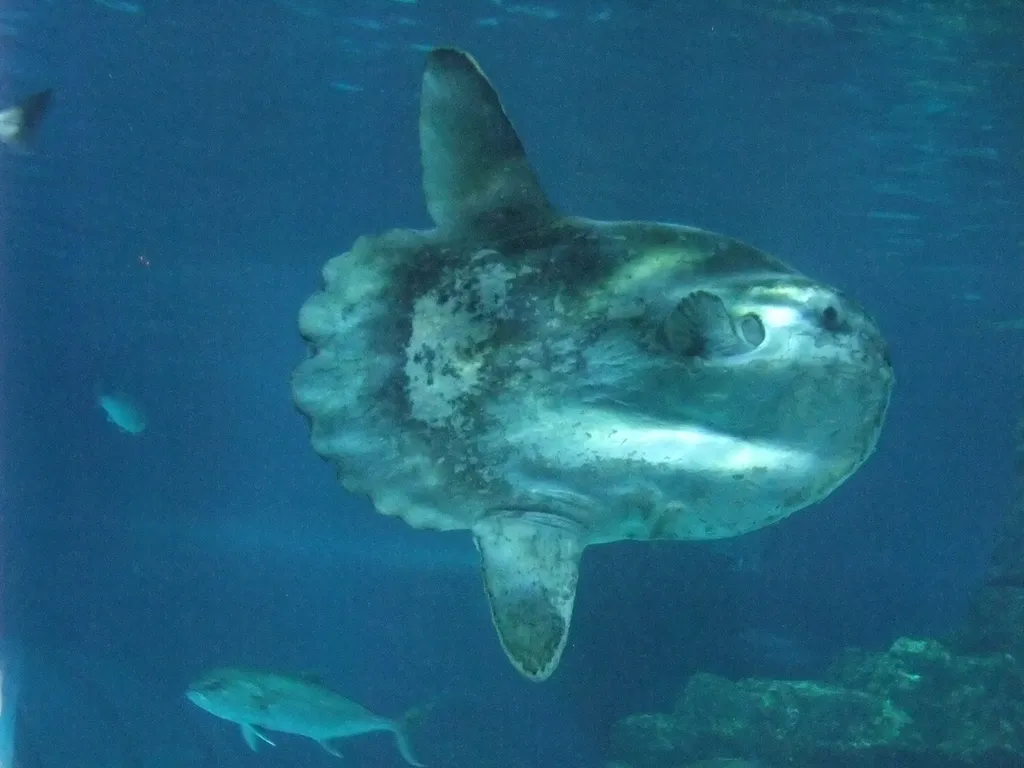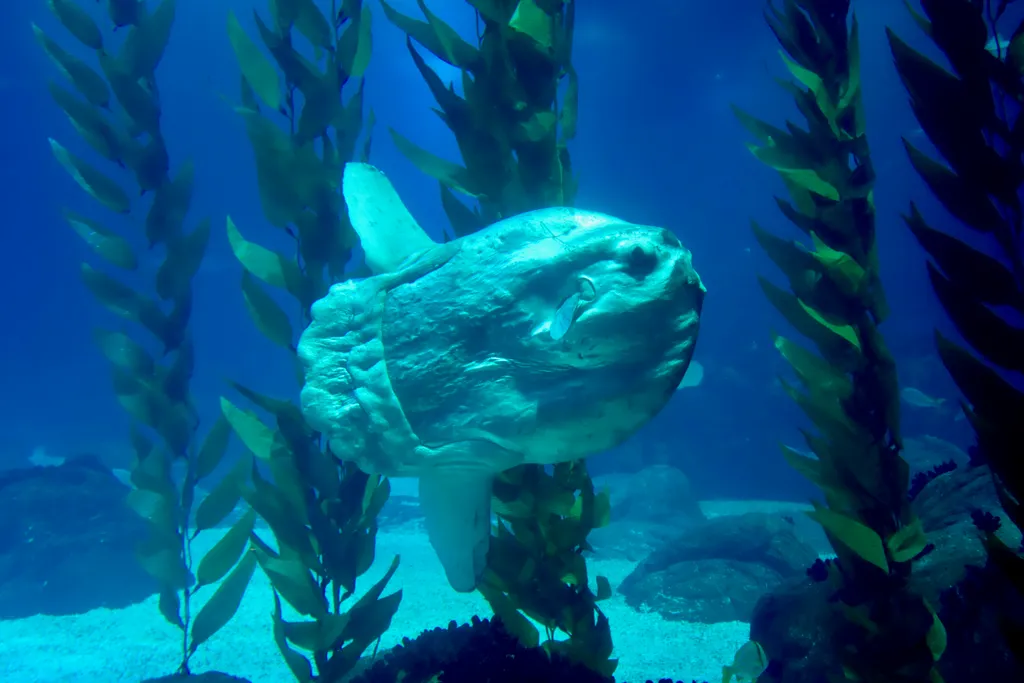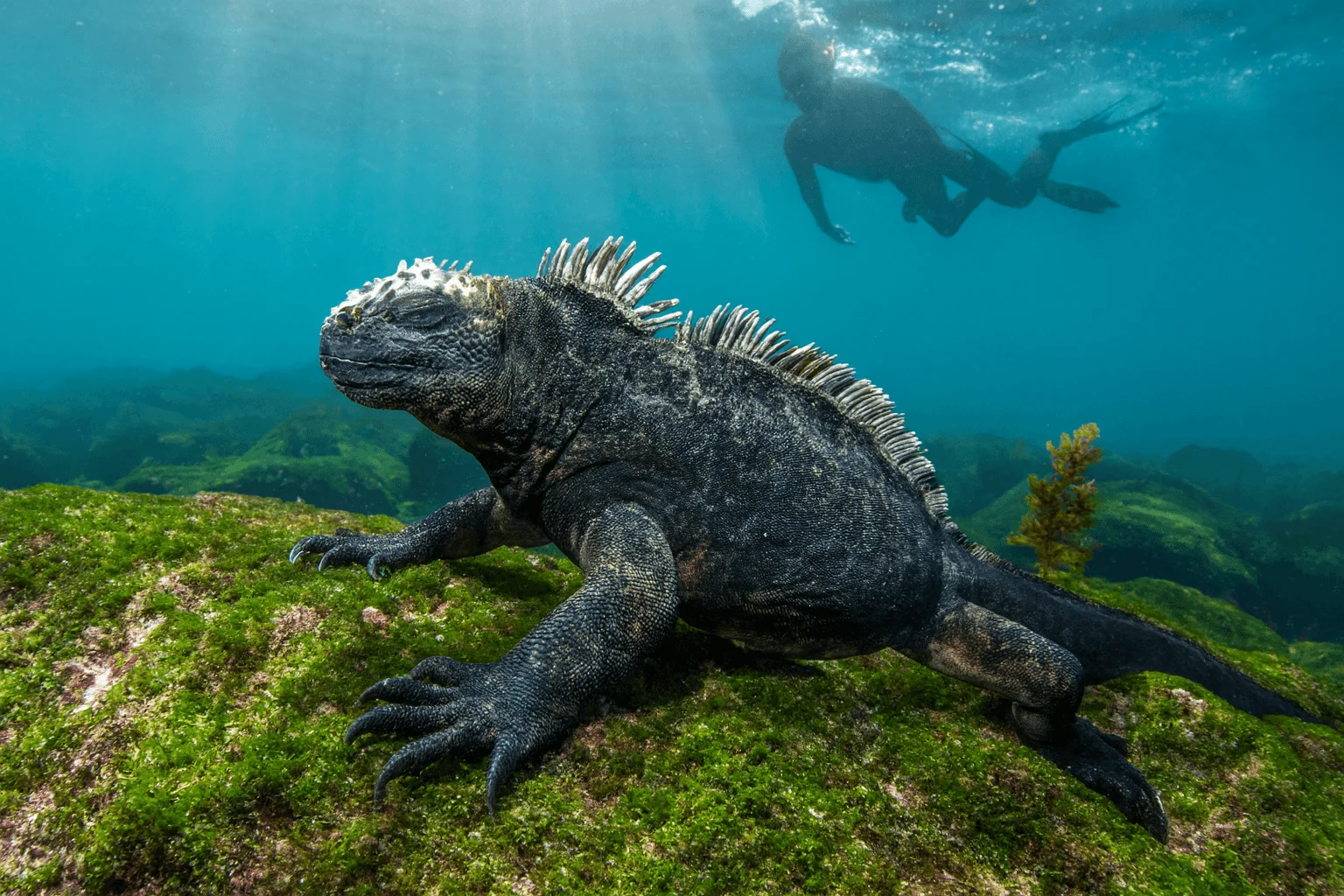Mola mola
Mola mola

Photo by Nol Aders / CC BY-SA 3.0 via Wikimedia Commons
The Mola mola, or Ocean Sunfish, is the heaviest bony fish in the world and arguably the weirdest. Looking like a giant floating head that lost its body, it can weigh more than a car and grow up to 3 meters tall. Despite their massive size, they feed almost exclusively on jellyfish, slurping them up like spaghetti. They are famous for "basking" sideways on the surface to warm up after deep, cold dives. Gentle, goofy, and infested with parasites, they are the holy grail for many divers, especially in places like Bali.
🔬Classification
📏Physical Features
🌊Habitat Info
⚠️Safety & Conservation
Identification Guide

Photo by U.S. National Oceanic and Atmospheric Administration via Wikimedia Commons
Field marks:
- Shape: A giant, flat, disc-like body that looks truncated (cut off) at the back.
- Fins: Two massive fins (dorsal and anal) that wave in unison like vertical oars; no tail fin (caudal fin), instead a rudder-like "clavus".
- Mouth: Small, permanently open mouth with fused teeth (beak-like).
- Movement: Sculls slowly through the water; often seen drifting sideways at the surface.
- Size: Absolutely massive. You won't mistake it for anything else.
Juvenile vs. Adult
Larval Molas look like tiny spiky pufferfish (less than 5mm). They lose the spikes and grow a "tail" as they mature. The growth from larva to adult is an increase in mass of over 60 million times!
Top 10 Fun Facts about Mola mola

Photo by Javi Guerra Hernando / CC BY-SA 4.0 via Wikimedia Commons
1. The Floating Head
The scientific name Mola means "millstone" in Latin, describing its round, grey, rough body. Germans call it Schwimmender Kopf ("swimming head"), which is biologically accurate because they literally lack a true tail section. Evolution just decided to delete the back half of the fish.
2. Sunbathing Giants
Why are they called "Sunfish"? Because they love to sunbathe. After diving hundreds of meters deep into freezing water to hunt squid and siphonophores, they return to the surface and lay flat on their side. This "thermal recharging" raises their body temperature so they can digest food and dive again.
3. The Ultimate Egg Layer
Female Molas are the supermoms of the ocean. A single female can carry up to 300 million eggs at once—more than any other vertebrate on Earth. If all of them survived, the ocean would be a solid block of sunfish in a week. Luckily (or unluckily), survival rates are one in a million.
4. From Popcorn to Titan
Mola larvae are tiny (2.5 mm), spiky balls that look like cartoon pufferfish. By the time they reach adulthood, they can weigh 2,000 kg. That’s a growth increase of 60 million times their starting weight. Imagine a human baby growing to the size of six Titanics.
5. Jellyfish Vacuum
How do you get to be 2 tons eating mostly water? By eating A LOT of it. Their diet is primarily nutrient-poor jellyfish. They have to consume massive quantities of jellies, salps, and ctenophores to sustain their bulk. It’s an endless buffet of gelatin.
6. Parasite Hotel
Being a slow, giant plate in the ocean makes you a target. Molas are infested with up to 40 different species of parasites—some even live in their eyes! This is why they visit cleaning stations.
7. Breach for Relief
Despite their clumsy look, Molas can breach! They launch their 1-ton bodies out of the water, landing with a massive belly flop. Scientists believe this is a desperate attempt to dislodge parasites from their skin. It’s the world’s biggest splash.
8. Bird Spa
When fish cleaners aren't enough, Molas surface and stick a fin out to attract seagulls and albatrosses. The birds land on the fish and peck out the parasites. It’s a rare case of fish-bird symbiosis.
9. Not So Slow
We used to think they just drifted with currents (planktonic), but tracking data shows they are active swimmers. They can cover 26 km a day and dive deeper than 600 meters. They just look lazy.
10. "Toppled Car" Fish
In Chinese, they are called "Fan Che Yu" (翻车鱼), meaning "Toppled Car Fish" or "Overturned Cart Fish," because their floating posture looks like a capsized wheel. Fishermen consider them bad luck to catch because the name implies a vehicle accident!
Diving & Observation Notes

Photo by Sonse / CC BY 2.0 via Wikimedia Commons
🧭 Finding Mola Mola
Bali (Nusa Penida) is the world capital for Mola sightings (July–Oct). Look for them at deep cleaning stations (Crystal Bay, Blue Corner). They hang vertically or at an angle, motionless, while bannerfish clean them. Look for the silhouette of a giant plate fading into the deep blue.
🤿 Approach & Behavior
- Be Invisible: They are extremely shy and easily startled by bubbles. Approach slowly and do not swim directly at them.
- Wait Your Turn: If a Mola is at a cleaning station, stay back (10m+). If you rush in, it will leave, ruining the show for everyone.
- No Chasing: You cannot outswim a Mola. If it turns away, let it go. Chasing stresses them.
- Bubble Control: Try to breathe gently. Loud, explosive bubbles scare them off.
📸 Photo Tips
- Wide Angle: You need a wide lens. They are huge.
- Silhouette: Shooting up from below against the sun creates a dramatic silhouette of their alien shape.
- Diver for Scale: Include a diver in the frame; otherwise, it just looks like a weird cookie. You need the reference to show it’s the size of a door.
⚠️ Ethics & Safety
- Do Not Touch: They have a protective mucus layer. Touching removes it and leads to infection.
- Deep Dives: Mola dives are often deep (30m+) with strong, cold currents (thermoclines). Watch your NDL and air.
- Flash: Avoid blasting them with strobes if they are shy; it can spook them.
🌏 Local Guide Nuggets
- Nusa Penida (Bali): "Crystal Bay" is the classic spot, but it’s crowded. "Blue Corner" has more currents but often bigger/more Molas.
- Galapagos: Often seen at Punta Vicente Roca, cleaning in the cold upwellings.
- Alor (Indonesia): Sometimes seen surfacing in the channel currents.
Best Places to Dive with Mola mola

Lembongan
Nusa Lembongan and its neighbouring islands sit on the edge of the Lombok Strait, where strong currents carry nutrient‑rich water between the Pacific and Indian oceans. This constant water flow produces clear visibility and supports vibrant reefs full of reef fish, trevallies and reef sharks. The area is famous for exhilarating drift dives; experienced divers drop into channels and ride the current over coral walls and slopes. Pelagic highlights include year‑round manta rays at nearby Manta Point and Manta Bay, while the rare ocean sunfish (Mola alexandrini) visits from July–October when cold upwellings bring temperatures as low as 16 °C. Beginner divers aren’t forgotten—sheltered sites like Lembongan Bay and Mangrove offer calm conditions, sandy bottoms and colourful coral gardens. With easy access by fast boat from Bali, Lembongan provides a perfect base to explore the more than two dozen sites around the Nusa islands.

Galapagos
The Galápagos Islands sit 1 000 km off mainland Ecuador and are famous for their remarkable biodiversity both above and below the water. Created by volcanic hot spots and washed by the converging Humboldt, Panama and Cromwell currents, these remote islands offer some of the most exhilarating diving on the planet. Liveaboard trips venture north to Darwin and Wolf islands, where swirling schools of scalloped hammerheads and hundreds of silky and Galápagos sharks patrol the drop‑offs. Other sites host oceanic manta rays, whale sharks, dolphins, marine iguanas, penguins and playful sea lions. Strong currents, cool upwellings and surge mean the dives are challenging but incredibly rewarding. On land you can explore lava fields, giant tortoise sanctuaries and blue‑footed booby colonies.